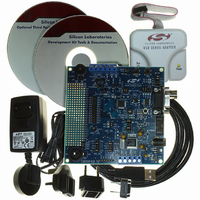C8051F410DK Silicon Laboratories Inc, C8051F410DK Datasheet - Page 168

C8051F410DK
Manufacturer Part Number
C8051F410DK
Description
KIT DEV FOR C8051F41X
Manufacturer
Silicon Laboratories Inc
Type
MCUr
Specifications of C8051F410DK
Contents
Evaluation Board, Power Supply, USB Cables, Adapter and Documentation
Processor To Be Evaluated
C8051F41x
Interface Type
USB
Silicon Manufacturer
Silicon Labs
Core Architecture
8051
Silicon Core Number
C8051F410
Silicon Family Name
C8051F41x
Lead Free Status / RoHS Status
Contains lead / RoHS non-compliant
For Use With/related Products
Silicon Laboratories C8051F41x
Lead Free Status / Rohs Status
Lead free / RoHS Compliant
Other names
336-1314
Available stocks
Company
Part Number
Manufacturer
Quantity
Price
Company:
Part Number:
C8051F410DK
Manufacturer:
Silicon Labs
Quantity:
135
- Current page: 168 of 270
- Download datasheet (2Mb)
C8051F410/1/2/3
19.2. External Oscillator Drive Circuit
The external oscillator circuit may drive an external crystal, ceramic resonator, capacitor, or RC network. A
CMOS clock may also provide a clock input. For a crystal or ceramic resonator configuration, the crys-
tal/resonator must be wired across the XTAL1 and XTAL2 pins as shown in Option 1 of Figure 19.1. A
10 M resistor also must be wired across the XTAL1 and XTAL2 pins for the crystal/resonator configura-
tion. In RC, capacitor, or CMOS clock configuration, the clock source should be wired to the XTAL2 pin as
shown in Option 2, 3, or 4 of Figure 19.1. The type of external oscillator must be selected in the OSCXCN
register, and the frequency control bits (XFCN) must be selected appropriately (see SFR
Definition 19.3. OSCXCN: External Oscillator Control).
Important Note on External Oscillator Usage: Port pins must be configured when using the external
oscillator circuit. When the external oscillator drive circuit is enabled in crystal/resonator mode, Port pins
P1.0 and P1.1 are used as XTAL1 and XTAL2 respectively. When the external oscillator drive circuit is
enabled in capacitor, RC, or CMOS clock mode, Port pin P1.1 is used as XTAL2. The Port I/O Crossbar
should be configured to skip the Port pins used by the oscillator circuit; see
Section “18.1. Priority Cross-
bar Decoder” on page 149
for Crossbar configuration. Additionally, when using the external oscillator cir-
cuit in crystal/resonator, capacitor, or RC mode, the associated Port pins should be configured as analog
inputs (with ‘1's in the corresponding Port Latch). In CMOS clock mode, the associated pin should be con-
figured as a digital input . See
Section “18.2. Port I/O Initialization” on page 151
for details on Port
input mode selection.
The frequency of the external oscillator can be measured with respect to the smaRTClock Oscillator using
Timer 2 or Timer 3. Section “
24.2.3. External/smaRTClock Capture Mode
” on page
241
shows how this
can be accomplished.
19.2.1. Clocking Timers Directly Through the External Oscillator
The external oscillator source divided by eight is a clock option for the timers (
Section “24. Timers” on
page 231
) and the Programmable Counter Array (PCA) (
Section “25. Programmable Counter Array
(PCA0)” on page 249
). When the external oscillator is used to clock these peripherals, but is not used as
the system clock, the external oscillator frequency must be less than or equal to the system clock fre-
quency. In this configuration, the clock supplied to the peripheral (external oscillator / 8) is synchronized
with the system clock; the jitter associated with this synchronization is limited to ±0.5 system clock cycles.
19.2.2. External Crystal Example
If a crystal or ceramic resonator is used as an external oscillator source for the MCU, the circuit should be
configured as shown in Figure 19.1, Option 1. The External Oscillator Frequency Control value (XFCN)
should be chosen from the Crystal column of the table in SFR Definition 19.3. For example, a 12 MHz crys-
tal requires an XFCN setting of 111b.
168
Rev. 1.1
Related parts for C8051F410DK
Image
Part Number
Description
Manufacturer
Datasheet
Request
R
Part Number:
Description:
SMD/C°/SINGLE-ENDED OUTPUT SILICON OSCILLATOR
Manufacturer:
Silicon Laboratories Inc
Part Number:
Description:
Manufacturer:
Silicon Laboratories Inc
Datasheet:
Part Number:
Description:
N/A N/A/SI4010 AES KEYFOB DEMO WITH LCD RX
Manufacturer:
Silicon Laboratories Inc
Datasheet:
Part Number:
Description:
N/A N/A/SI4010 SIMPLIFIED KEY FOB DEMO WITH LED RX
Manufacturer:
Silicon Laboratories Inc
Datasheet:
Part Number:
Description:
N/A/-40 TO 85 OC/EZLINK MODULE; F930/4432 HIGH BAND (REV E/B1)
Manufacturer:
Silicon Laboratories Inc
Part Number:
Description:
EZLink Module; F930/4432 Low Band (rev e/B1)
Manufacturer:
Silicon Laboratories Inc
Part Number:
Description:
I°/4460 10 DBM RADIO TEST CARD 434 MHZ
Manufacturer:
Silicon Laboratories Inc
Part Number:
Description:
I°/4461 14 DBM RADIO TEST CARD 868 MHZ
Manufacturer:
Silicon Laboratories Inc
Part Number:
Description:
I°/4463 20 DBM RFSWITCH RADIO TEST CARD 460 MHZ
Manufacturer:
Silicon Laboratories Inc
Part Number:
Description:
I°/4463 20 DBM RADIO TEST CARD 868 MHZ
Manufacturer:
Silicon Laboratories Inc
Part Number:
Description:
I°/4463 27 DBM RADIO TEST CARD 868 MHZ
Manufacturer:
Silicon Laboratories Inc
Part Number:
Description:
I°/4463 SKYWORKS 30 DBM RADIO TEST CARD 915 MHZ
Manufacturer:
Silicon Laboratories Inc
Part Number:
Description:
N/A N/A/-40 TO 85 OC/4463 RFMD 30 DBM RADIO TEST CARD 915 MHZ
Manufacturer:
Silicon Laboratories Inc
Part Number:
Description:
I°/4463 20 DBM RADIO TEST CARD 169 MHZ
Manufacturer:
Silicon Laboratories Inc











